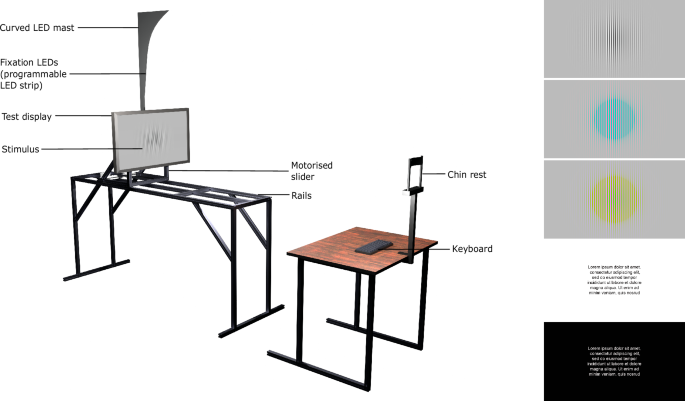Copyright nature

Foveal resolution limit Figure 2a reports the measured resolution limit for achromatic, red-green, and yellow-violet patterns. The experiment measured the highest resolution that can be reliably detected by an observer at various eccentricities from the fovea. The resolution is expressed in pixels per degree or ppd. The corresponding maximum spatial frequency in cycles per visual degree is equal to half of the reported ppd values. The thresholds are reported for detecting a high-contrast Gabor patch as well as for identifying a decrease in resolution in black text on a white background, and white text on a black background simulating dark mode. The detailed breakdown of the mean, median, and 95th percentile threshold ppd values observed across different colour directions and eccentricity levels are provided in the Supplementary Table 2. First, we will focus on the results for foveal vision, corresponding to an eccentricity of 0°. The widely accepted 20/20 vision standard, established by Snellen, suggests that the human eye can resolve detail at an angular resolution of 1 min of arc, which corresponds to 60 pixels per degree (ppd) (Supplementary Section 2—“Visual acuity units conversion”) details the conversion between these units). This measure is derived from the design of the Snellen chart, where the smallest letters on the 20/20 line subtend an angle of 5 min of arc, with each critical feature of these letters subtending 1 min of arc when viewed from 20 feet or 6 m22,23. This 1 arc minute value has historically been considered the threshold for human visual resolution, discussed in more detail in the Supplementary Section 1 (“Historical context of visual acuity standards”), leading to the assumption that 60 ppd is sufficiently high for display purposes. However, younger observers with no optical abnormalities usually have acuities better than 20/20. In the context of displays, the Ultra Retina XDR display found in the 7th generation Apple iPad Pro (2024, 13”) has an effective resolution of 65 ppd when viewed from 35 cm away, the shortest comfortable viewing distance. Both the 20/20 assumption and the Retinal display resolutions are significantly lower than the population mean of 94 ppd we measured in our experiment, or individual values as high as 120 ppd (see Supplementary Fig. 5). This demonstrates that the 60–65 ppd range is not the “retinal resolution” for a display. Note that high-contrast content, such as our Gabor patch stimulus, is not outside of the norm for content typically seen on displays: notably, text is often rendered at maximum contrast. To demonstrate, we also measured the detection threshold for text, both black-on-white and white-on-black (dark mode), and obtained values closely matching the resolution limit for sinusoidal gratings, as indicated by the “Text” data points in Fig. 2a. Our results clearly indicate that the resolution limit of the eye is higher than broadly assumed in the industry. It could also be surprising that the foveal resolution limit of red-green patterns is similar to that of achromatic patterns—89 ppd for red-green vs. 94 ppd for achromatic. It must be noted, however, that we did not try to isolate observers’ individual chromatic mechanisms via the heterochromatic flicker paradigm24, as we wanted to capture data that could generalise across the population. Our results cast doubt on the common practice of chroma sub-sampling found in almost every lossy image and video format, from JPEG image coding to H.265 or AV1 video encoding. The assumption of chroma subsampling is that the resolution of chromatic channels can be reduced twofold in relation to the achromatic channel due to the lower sensitivity of the visual system to high-frequency chromatic contrast. Our data suggests that this only holds for the yellow-violet colour direction, with the maximum resolution of 53 ppd, but not for the red-green direction, consistent with the vision science theory that the isoluminant red-green pathway is the most sensitive opponent-colour channel of the human visual system25. Resolution limit in periphery Figure 2a shows the rapid decline of the resolution limit as the stimulus was presented at increased eccentricities. This is in line with the established understanding that visual acuity and colour discrimination decrease as the stimulus moves away from the fovea, primarily due to the fall-off in cone density and the increase in receptive field size in the retina4,26. The notable aspect of our results is that the resolution limit declines with increased eccentricity differently across colour directions. The achromatic resolution limit declines 2.3× between foveal vision and 10° eccentricity, while red-green declines 4.9× and yellow-violet 4.8×. Popular techniques, such as foveated rendering27,28 or foveated compression29, are optimised for achromatic vision. Our results suggest that these techniques could provide further computational and bandwidth savings by lowering the resolution requirements for the chromatic channels. Modelling the resolution limit To interpolate and extrapolate our measurements, we fit the contrast sensitivity model presented by Watson (2018)30: where Sc is the contrast sensitivity of the colour channel c for a given stimulus at eccentricity (e) and spatial frequency (ρ). S0 is the baseline sensitivity affected by other stimulus parameters (luminance, temporal frequency, size, etc). kρ and ke are the parameters of the model representing linear decrease with respect to spatial frequency and retinal eccentricity, respectively. The contrast sensitivity S is the inverse of the contrast of the stimulus. In our study, the contrast value is fixed for each colour direction (values reported in the Supplementary Table 1). We optimise the values of S0, kρ and ke to predict the measured ρ values from our data. The rearranged equation predicting the spatial frequency threshold as an inverse factor of eccentricity follows: The fitted model is drawn as dashed lines in Fig. 2a. More details of the fitting procedure and the parameter values are provided in the Supplementary Section 4.3 ("Parameters of the resolution limit model”). Resolution limit across the population In practical applications, it is important to know how the resolution limit varies across the population. This lets us make decisions that are relevant for the majority of the population. For example, designing a display which has “retinal resolution” for 95% of people rather than an average observer. To model the variation of the resolution limit in populations, we used the model from Eq. (2) to find the mean threshold, and then fitted a normal distribution to the per-observer data. To estimate the probability distribution at eccentricities not measured in our dataset, we linearly interpolated the parameters of the Gaussian distribution as detailed in the Supplementary Section 4.4 ("Probability distribution across the population”). The cumulative distribution, shown in Fig. 2b, demonstrates a large variation across the population, especially at eccentricity. For example, if a median observer can see up to 22 ppd at 20° eccentricity, this value increases to 35 ppd for the 95th percentile of our sample. This shows the importance of considering individual differences in populations when designing technology aligned with human vision. Additionally, we also tested the effect of viewing distance on the resolution limit, but did not observe a consistent trend among our sample of observers. More details of this investigation are discussed in the Supplementary Section 4.5 ("The effect of viewing distance”). We may also want to know how the resolution limit, expressed in ppd units, translates to actual displays and viewing distances. This is shown in Fig. 2c, where we plot the relationship between the display resolution (number of horizontal lines) and the viewing distance (measured in display heights). Our model predictions can be compared with the ITU-R BT.2100-231 recommended viewing distances for television, shown as red horizontal lines in Fig. 2c. Since Full HD (FHD) resolution was not designed to deliver a perfect image, the ITU recommendation of 3.2 display heights falls short of the reproduction below the visibility threshold. Our model indicates that a distance of at least 6 display heights would be necessary to satisfy the acuity limits of 95% of the observers. For 4K and 8K displays, the ITU suggests viewing distances of 1.6–3.2 and 0.8–3.2 display heights, respectively. Our model shows that those ranges are overly conservative and there is little benefit of 8K resolution when sited further than 1.3 display heights from the screen. Used in this way, our model provides a framework to update existing guidelines and to establish new recommendations based on the limitations of our vision. In Fig. 2d, we plot the relation between pixel density (in pixels-per-inch) and viewing distance and show the screen resolution for two different devices. To allow the readers to test their own displays, we created an online display resolution calculator available here. Example: foveated rendering Foveated rendering, found in many commercial XR headsets, reduces the quality of rendered content depending on how far is a portion of the screen from the gaze location27,28. Foveated rendering typically reduces the resolution of rendered content to save bandwidth and the computational cost of rendering. The majority of foveated rendering methods consider only the perception of achromatic contrast and are manually tuned. Here, we show how our measurements could be used to find the right thresholds for foveated rendering for achromatic and chromatic contrast. Here, we consider a simplified task of foveated filtering, which could improve video compression in foveated streaming—we remove the high-frequency contrast that is invisible to the human eye. To produce the result shown in Fig. 3, we decompose an image into achromatic, red-green and yellow-violet components of the DKL colour space32, decompose it into frequency bands using a Laplacian pyramid33, and then set to zero the coefficients below the threshold contrast for a given eccentricity according to our fitted model for an average observer. More details of the image simulation can be found in the Supplementary Section 4.6 ("Foveated filtering”). When the reconstructed image in Fig. 3 is seen from the right distance, and the gaze is directed towards the 0° target, the loss of resolution at larger eccentricities should be invisible.



